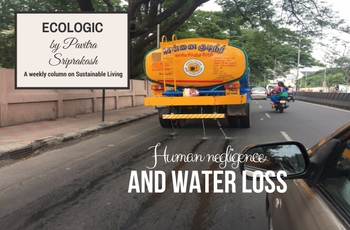12 Aug 2017, New Indian Express: ECOLOGIC- Pavitra Sriprakash, the Chief Designer and Director of Shilpa Architects writes about water management and ground water exploitation.
Full Article:
Human negligence and water loss
There was a time when we relied on wells at home for sweet water. Tankers now careen around through city traffic spilling water along roadways, as people anxiously await their turn for the next ‘load’. We may despair how things got so bad.
Nearly 70% of Earth’s surface is covered with water, yet we are called Earth instead of ocean! We learnt at school that water from the soil, plants, lakes and seas turns into water vapour through evaporation caused by the sun.
More than 95% of earth’s water is saline, less than 1% is freshwater, and 2-3% is contained in glaciers and ice caps. The vapours condense as clouds and come back to earth as rain and snow which flow into lakes, rivers and the oceans. Some water percolates into aquifers, where they could move for several years until discharged back onto the surface. This is the eternal and continuous water cycle.
The ‘U.S. Global Change Research Program Climate Science Special Report,’ compiled by a group of scientists found with high confidence that it was “extremely likely that more than half of the global mean temperature increase since 1951 was caused by human influence on climate.” This report is part of the National Climate Assessment, which has been congressionally mandated to be conducted at least every four years since 1990.
Science has shown that climate change has affected every ecosystem and natural cycle of the planet — the water cycle being no exception. If any parameter in it changes, the entire cycle gets affected. Sixteen of the 17 warmest years in the 136-year record have occurred since 2001.
More water evaporates into the air with warmer temperatures; warmer air holds more water vapour leading to more intense rainstorms. These in turn cause problems like extreme flooding due to excessive runoffs. Higher temperatures increase evaporation over land causing soil to dry out. When it does rain, a lot of the water runs off the hardened ground into rivers and streams with no recharge along the way.
Chennai’s daily water requirement is about 1,400 million litres per day (MLD). About 40% of this is met by the CMWSSB, and the balance 840 MLD is met from lakes and groundwater sources in and around Chennai. Maybe 30% of piped water is lost through leaking joints underground.
Though cities rely heavily on groundwater, the latter is used predominantly for agriculture. It’s unfortunate that most do not hesitate to contaminate groundwater with nitrates, sewage, pharmaceuticals and plastics. Somehow society must urgently ensure the health of the water cycle from abusive exploitation.
The next time you call for a tanker of water, think about our groundwater, climate change, wastage, use and disposal. Surprise yourself by the things you can bring yourself to do for the ecosystem and the environment— for the health of your home, our city and humankind’s planet. Frankly speaking, it is limitless!
Link to PDF / Online Paper



